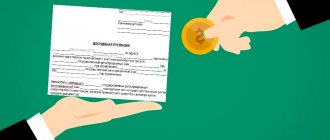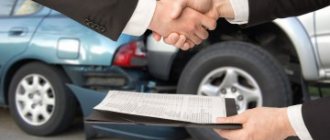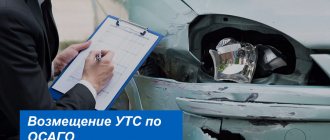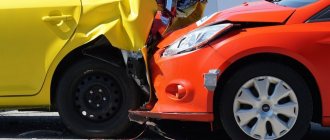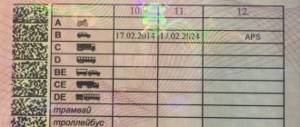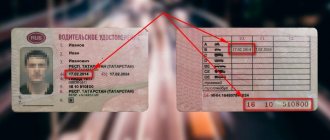Publication date: 03/04/2019 Number of views: 5702
Author: Ermakov Andrey Valerievich Lawyer, partner of the Legal Agency of St. Petersburg Articles written: 20
The situation when an insurance company files a lawsuit against the culprit of an accident in order to recover material damage based on the compensation paid to the injured party is becoming more and more common every year. If previously relatively little-known organizations that had close ties with collection agencies committed similar sins, today you can get a claim for subrogation or recourse from almost any insurance company. Recently, there has been increased activity on the part of the insurance company, which is trying to compensate for its losses under CASCO or OSAGO contracts by filing lawsuits against those responsible for the accident. There is a trend: if the accident occurred in 2015 or 2021 (the statute of limitations is about to expire), and the amount of paid material damage exceeds 100-120 thousand rubles, you can expect a quick summons from the court. There are many explanations for this: the unstable economic situation in the country, a sharply increased number of vehicles, competition in the market, tightening legislation in the field of insurance companies. In order to somehow preserve their assets and not become bankrupt, they are forced to resort to subrogation and recourse claims. What to do if the insurance company sues the person responsible for the accident, what is the difference between recourse and subrogation, is it possible to reduce the amount of payments for a lawsuit and how to protect your property rights? Answers to these and related questions are provided by professional lawyers in the field of insurance law and civil law.
Is a partial refund possible?
The insurer pays damages according to the amount determined by the vehicle assessment expert.
The most common situations occur when an expert establishes a certain amount of damage, after which the victim declares that the damage caused is more than established. In these cases, the victim turns to the culprit of the incident with a demand to pay the resulting difference. The appeal occurs to the culprit, and not to the insurance company, precisely because it will be much easier to receive payment directly from a specific person than from the insurance company.
In what cases is compensation required?
Insurance claim: rules for filing
Insurance Fraud
Pre-trial settlement of insurance disputes
There are several cases in which insurance companies require the culprit to pay for damages from an accident:
- By way of subrogation (Article 965 of the Civil Code of the Russian Federation), the insurance company demands that the culprit reimburse the funds that it paid to its client under CASCO. Thus, initially the insurance company pays money to its client, after which it recovers the same amount from the culprit of the accident;
- By way of recourse (Article 1081 of the Civil Code of the Russian Federation) under compulsory motor liability insurance, in accordance with Federal Law No. 223, Article 14 . In other words, the insurer demands compensation for the damage that was paid to the victim under the compulsory insurance policy.
The reasons for applying recourse are special illegal actions of the perpetrator of the incident, which are discussed in detail in Article 14 of the Federal Law.
Namely:
- The culprit of the accident specifically caused harm to the life or health of the victim;
- The culprit caused harm while driving in a state of alcohol (or other) intoxication;
- The culprit did not have the right to use the car (for example, there was no license);
- The culprit fled the scene of the accident.
Required evidence for recovery
Order of the Ministry of Internal Affairs No. 664 of August 23, 2021 abolished the need to issue a certificate of an accident. All information about the incident is entered into the protocol. The document displays the date and time of the incident, the location of the incident, a list of persons who participated in the accident, a list of violations committed and their connection to the current legislation.
However, to successfully collect payment from the culprit of an accident, one protocol is not enough. Based on information agreed upon with all participants in the accident, the following data is recorded:
- Movement pattern. The location of each person at the time of the incident is documented.
- Evidence. They are attached to the protocol. Then the data about them is entered into the inventory.
- Photos or videos from the scene of the accident.
- Testimony of witnesses. They can help explain the events that occurred.
- Vision of events by a traffic police officer. The information is recorded in the report.
The protocol contains a column that lists the violations committed. The culprit may be subject to civil or administrative liability. If there is no basis, the case will not be initiated. Information about this is recorded in the protocol. Instead of a standard certificate, the traffic police officer provides other documents:
- A copy of the protocol. Issued at the scene of the accident.
- Resolution on the commission of an offense. The document is prepared in accordance with administrative regulations.
- The decision to initiate administrative proceedings based on the accident or refusal to carry out the process.
Based on interviews with witnesses, the following information must be recorded;
- Vehicle speed. If the exact value of the indicator is unknown, an approximate figure is indicated.
- The presence of a passenger in the car, the presence of heavy cargo or other features.
- Distance to the car at the moment when the victim realized the danger.
- Damaged vehicle components and the extent of their damage.
- Opinion about the correspondence of the accident location with the traffic pattern.
- The moment the driver takes measures to protect against a collision. This item indicates when the person tried to brake or turn the steering wheel. Then the approximate route to the collision is indicated.
Attention
When going to court in 2021 to recover damages from the culprit of an accident, the victim is obliged to attach to the claim the entire above list of documents and other evidence. Additionally, it is worth drawing up a petition to claim the administrative case that was initiated following the accident. The main evidence is an expert opinion. It is compiled based on the results of an assessment of the breakdown of vehicle components and the cost of work that is necessary to restore them.
Pre-trial practice
Pre-trial proceedings are carried out, as a rule, with subrogation under CASCO. Initially, the insurance company does not sue the culprit, but sends him a claim, urging him to compensate for the damage of his own free will. It is worth noting that the culprit may receive a letter of claim 2 – 2.5 years after the traffic accident. However, here it is important to understand how justified the requested amount is and whether you need to defend your rights or is it better to agree on an installment plan. As a rule, insurance companies are cooperative when it comes to installment plans.
Pre-trial proceedings
Current legislation provides for a pre-trial procedure, which precedes the filing of a civil claim directly in court.
Now the first step towards resolving a controversial issue peacefully is to raise a pre-trial claim. If the parties manage to reach an agreement, they can significantly save their own time and money by avoiding costly and lengthy court proceedings.
As a rule, insurers file a pre-trial claim as part of CASCO subrogation. After all, recourse claims under compulsory motor liability insurance can be sent to the culprit of the incident only if his guilt is proven in court.
How to file a pre-trial claim
There are often cases when the insurer did not bother collecting evidence, and the demand from him came to the addressee in the form of a letter containing:
- brief information about the incident;
- financial claims against the person through whose fault the accident occurred, leading to compensation for damage;
- links to legislative acts;
- amount required for payment.
The form of the pre-trial claim is indeed not approved by law, therefore the initiator has the right to draw it up in any form. However, the recipient should be aware that such a document will not be legal if it does not contain a number of mandatory sections and information, and also if it is not accompanied by documentary evidence of the specified information and requirements.
A properly drafted pre-trial document must contain:
- Personal data of the addressee.
- Details of the accident.
- Expert opinions.
- Information provided by witnesses.
- The amount required to be paid.
- Name and contact details of the insurance company.
- Time limit for consideration of a claim.
- Links to regulations.
To confirm the stated information, the insurer must attach to the claim:
- calculation of the amount of damage compensated to the injured party;
- a report from an independent expert with attached photographs of the scene of the incident;
- confirmation of the fact of insurance payment;
- certificate of traffic accident from the traffic police;
- resolution on an administrative offense;
- copies of the insurance policy and title of the damaged vehicle;
- a certificate confirming the occurrence of an insured event.
Procedure for filing a claim
It often happens that the insurance claim is a paper stating the fact of the accident, listing the articles of the law and issuing an invoice. This requirement is unfounded, since a number of documents must be attached to it, namely :
- Official papers confirming the amount of damage caused: a report on the inspection of the vehicle by experts with a detailed description of the damage. Original photographs and an estimate of the amount of repairs, or a receipt for payment must also be attached;
- Papers that confirm guilt: a certificate of a traffic accident, a conclusion on an administrative violation or a court conclusion;
- Papers that confirm the right to subrogation: a copy of the vehicle’s passport, a photocopy of the policy and payment receipt, a copy of the insured person’s statement that an insured event has occurred.
Additional documents:
- Only after the insurance company pays compensation to the victim does it have the right to recover funds from the culprit;
- Therefore, the amount of the monetary claim against the perpetrator must be within the amount paid to the victim.
Note: the employer must pay for the culprit of a traffic accident who became such while fulfilling his official obligations.
What to do if the insurance company sues the person responsible for the accident
There are often cases when the insurer demands compensation for damage through subrogation. Subrogation is a legal claim by the insurance company for damages incurred from the person at fault for the accident. Subrogation is valid for CASCO policies. In other cases, regression is used to compensate for damage - claiming the amount of compensation from the culprit of the accident.
If the insurer has filed a claim in court, this does not mean that you will be required to pay the full cost of the damage. It is advisable to immediately seek the help of a lawyer upon receiving a subpoena. A lawyer will help not only understand the situation and reduce the amount of damage, but also prove that the claims made are unlawful. It is important not only to be able to understand all the nuances of insurance law, but also to have experience in handling similar cases; when choosing a lawyer, you need to rely on these qualities.
Some recommendations on what to do before going to court.
- You should know exactly what demands the insurer made and on the basis of what evidence it decided that you are obligated to compensate for the damage. To receive a copy of the claim and all the documents that the plaintiff has attached, you must come with your passport to the court where the application was filed and request copies of the papers. Next, you need to compare the data in these documents with those that should have remained with you after the accident; it is possible to identify inconsistencies.
- The insurer always wants to recover the maximum amount of damage and not only compensate for the loss, but also make a profit. That is why claims are not sent immediately, but after several years. Due to the expiration of the deadline, the plaintiff can demand that the defendant reimburse the amount of compensation for the use of someone else’s funds (Article 395 of the Civil Code of the Russian Federation). In this case, the only solution will be to prove that you are completely or partially at fault for the incident. To do this, you need to conduct an independent examination, interview witnesses, and study documents about the accident.
- A lawyer, having carefully studied all the details of the case, can identify errors and inconsistencies that can be caught on. Some shortcomings may even lead to refusal to further consider the claim and dismissal of charges against the defendant.
- All documents presented by the insurer must be verified as authentic. In court, if there are any doubts about the veracity of the data presented, you can send a request for a forensic examination. Experts must determine whether all data is reliable. So, for example, during the examination it may turn out that the insurer specified the same part of the car several times or some faults cannot be attributed to an accident at all (the left side of the car was damaged, but the insurer indicates that the right side units need to be replaced). Such manipulations are already interpreted as fraud, so you should not skimp on paying for the services of an expert.
Litigation related to road accidents has never been simple. Insurance disputes are also not considered to be quickly resolved, but practice shows that if efforts are made, the insurer’s claim may not be completely satisfied. During the trial, the defendant may also seek reimbursement of costs (including attorney's fees) directly related to the case.
I got into an accident and am not guilty. Read here what to do if the insurance company refuses to pay.
About the claim against the culprit of the accident, read the link:
Legal assistance
If after an accident the insurance company demands compensation for damages, you should contact an experienced lawyer. He can use several protection methods:
- Reduce the amount of damage caused in an accident . If the insurance company reimburses the victim or its client, the at-fault party has the right to dispute the amount of the payment. The insurance company has the right to request compensation for damage only if it was correctly calculated;
- Appeal the legality of the payment . In this situation, a general legal examination of the official papers is carried out, which became the basis for the insurance company to pay its client. If it is discovered that there are errors in the documents, or if it is determined that there are not enough documents, the payment is considered illegal. Thus, the insurance company is deprived of the right to demand compensation for damage from the culprit of the road accident;
- Appeal the fault of the person responsible for the accident . In some cases, during an examination, lawyers reveal that the person at fault in the traffic accident is not guilty, or is partially guilty. And here, even when a claim has been received from the insurance company stating that you are the culprit of the road accident, you have the right to try to prove your innocence in court.
What to do if the insurance company demands compensation for damage
As a rule, insurance companies are in no hurry to make claims against the culprit of an accident without delay. Taking advantage of the fact that the Civil Code establishes a limitation period of three years, most often they file a claim at least 2-2.5 years after the road incident.
This is done intentionally, because over the course of several years, the chances that documents related to a long-standing incident will either be lost by its participants or thrown away as unnecessary increase many times over. And without documents, it is quite difficult to challenge claims from an insurance company or prove your own innocence in an incident.
What to do if the insurance company demands compensation for the damages it compensated for an accident? If you receive a letter with a claim, you should not panic, be tormented by memories of the incident, reproach yourself for carelessness, and also immediately agree to all the conditions outlined in it and estimate with what income and in what time frame it is possible to pay off all the monetary demands put forward. The received claim is a reason to deal with an unexpected and unpleasant situation that has arisen.
Experts say that the help of an experienced car lawyer can help:
- challenge the legality of the received claim;
- significantly reduce the amount of payment;
- prove your own innocence in a long-past incident.
Disputing guilt
Sometimes insurers demand the return of funds from the participant in the incident, who was in fact not the guilty party, but the injured party. The cause of such an error may be incorrect interpretation of data from the accident report. In such a situation, you have to prove your innocence in court.
Insurers, when sending a letter requesting a refund, refer to the data from the accident certificate issued by the traffic police inspectors.
The data of the administrative offense protocol, which identifies the person found guilty of the transport incident, is also of great importance. But most often, the guilt in a traffic accident is mutual for its participants, and experienced lawyers are able to prove their client’s partial guilt or even get him found not guilty of the accident.
Reducing damage
The amount of damages indicated in the claim may be significantly overestimated. Insurers do not hesitate to use the following techniques:
- overestimation of the cost of standard hours for restoration work;
- use in calculating the cost of spare parts at official dealer prices and without taking into account their natural wear and tear;
- discrepancy between the presented list of vehicle damage and that indicated in the accident certificate;
- inclusion of “extra” details in the calculation;
- accrual of penalties.
To establish the truth, you should:
- carefully study all documents referred to by the insurance company;
- if necessary, order an independent examination;
- if there are doubts about the reality of the amount of compensation calculated by the insurer, request a recalculation of costs.
As a result of the measures taken, the amount claimed by the insurance company may be significantly reduced.
Challenging legality
Having received claims for payment from insurers, the first thing you need to check is whether the statute of limitations allowed by law for filing claims has not expired. It should be borne in mind that the period for a regressive claim is calculated from the date of the incident, and in the case of subrogation, from the date of the insurance payment.
If the statute of limitations has not passed, you can (in case of disagreement with the received requirements) try to prove your rights during pre-trial or trial proceedings.
Can insurers cheat?
There are frequent cases when, during subrogation, the insurance company demands compensation for damage in an amount greater than that which was reimbursed to the client . For these purposes, they provide dubious calculations that can be easily challenged by a professional either before the trial or in court itself. This means that you should not immediately pay the invoice issued to you in your claim. When there is doubt about whether the repair amount is real, it is recommended to understand all the documents that contain information about the damage assessment, and also check the accuracy of all calculations. You can check your calculations by answering the questions below:
- To what extent do car repair work correspond to the damage indicated in the traffic accident certificate? Perhaps you will find damage that is not justified?
- Perhaps there are unnecessary parts on the list of parts to be replaced?
- Perhaps the same spare parts were counted several times?
- How realistic are the cost of parts and standard hours?
It happens when insurers falsify documents in the hope that the person responsible for the accident is incompetent. For example, the injured driver estimated the cost of repairing his car at a much higher amount than the insurance company paid him. And insurers, demanding compensation for losses, present the documents submitted by the victims to the culprit of the accident.
Tags:
Do I need to file a claim with the person at fault for the accident?
The mandatory nature of compliance with the pre-trial procedure for filing a claim with the person responsible for the accident is not provided for by law; therefore, this document is an option for agreeing on compromises and concessions to resolve the dispute before trial.
The injured person, when resolving the issue of compensation for harm as a result of an accident, can resort to drawing up a claim against the culprit in order to agree on compensation for (material, moral) damage on a voluntary basis, which can subsequently be settled by concluding an agreement between the participants in the accident or a receipt from the culprit .
There are often situations when the culprit voluntarily refuses to pay for the damage caused, then by filing a claim it is necessary to induce this, and also to show the seriousness of intentions to go to court if the requirements specified in the claim are not met.
USEFUL : order a claim from our lawyer, watch a video with tips on drawing up a procedural document for the second driver
